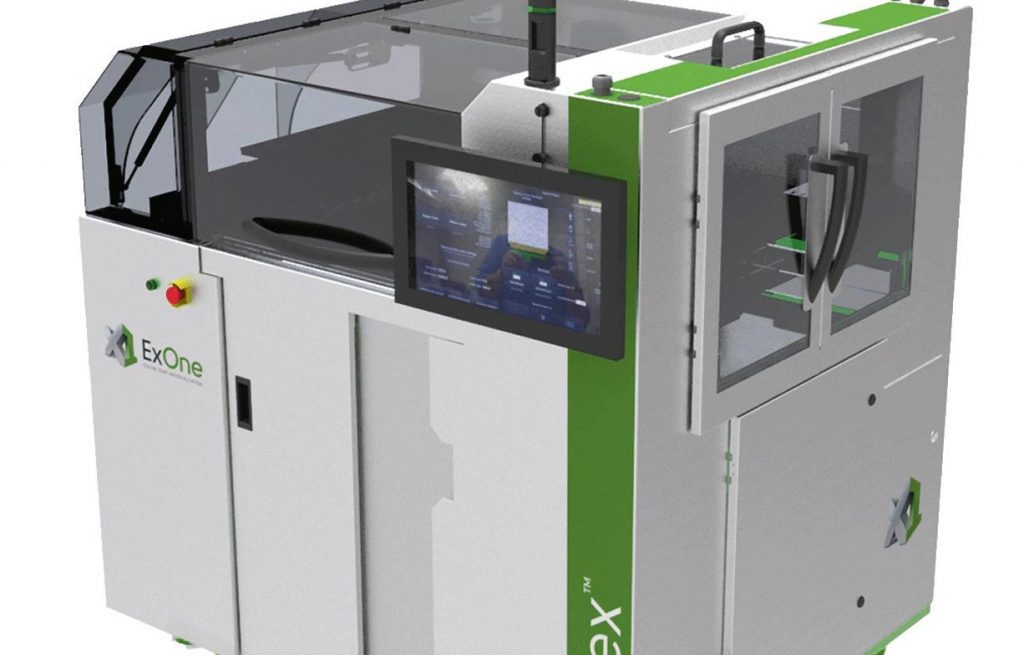Binder jetting 3D printer manufacturer ExOne has licensed a new printing method from Oak Ridge National Laboratory (ORNL) that will allow it to fabricate enhanced lightweight metal-ceramic parts.
ORNL’s patent-pending process, which it has been developing for 18 months, enables it to create aluminum-infiltrated boron carbide components with ExOne machines. Building on an existing R&D license between the firms, the latest deal now enables ExOne to use the technology commercially, by 3D printing scientific research parts and making it available to its clients.

ExOne’s binder jetting process
ExOne specializes in the production of binder jetting machines, and since licensing the technology in 1996, it has been integrated into many of its systems. The company’s current portfolio ranges from the entry-level InnoventPro to the high-volume X1 160PRO, and again, each features a variation of its proprietary process.
Essentially, ExOne’s technology involves jetting a binder onto a bed of metal, sand or ceramic to create shapes, which are then sintered to fuse the particles into a final part. In the past, the firm has utilized its process to meet the needs of military clients such as the U.S. Air Force, but recently it’s sought to build on its technology’s capabilities.
For instance, last year, ExOne issued $2.8 million to universities resolving known issues with binder jetting, while other collaborations yielded 21 new qualified materials. Now, an ongoing project with ORNL has also come to fruition, as the team there have managed to develop a method of binder jetting, in which materials can be infiltrated into a part during processing.

ORNL’s patent-pending approach
For nearly six years, ORNL has worked closely with ExOne to optimize the parameters of its systems, and enable them to process new materials such as H13 Tool Steel. In one such project, which started in July 2019, an ORNL-led team has now developed a novel process that allows boron carbide to be absorbed into aluminum alloys.
The resulting materials, known as a metal-matrix composites or ‘cermets,’ not only retain the strength of their host alloys, but are also lighter and feature neutron-absorbing properties. Such qualities make the composites particularly useful for creating neutron scattering instruments, which effectively enable scientists to capture data at an atomic level.
Seeing the process’ potential, ExOne first licensed it for R&D purposes in 2019, and after its latest agreement, this has been extended to allow its commercial use as well. The renewed license covers U.S. patent no.16/155,134, and the production of “Collimators and Other Components from Neutron Absorbing Materials Using Additive Manufacturing,” as well as two other provisional filings.
Following the deal, ExOne intends to continue working with ORNL to fabricate various matrix composite components for use within its neutron experiments. Having commercially licensed the novel binder jetting method, ExOne is also set to offer it to its clients, providing them with a new means of producing lightweight energy-absorbing metal-ceramic parts.
Harnessing ceramic’s potential
While the energy absorption qualities of ceramics are well-known, their inherent fragility and complex sintering requirements have often made them difficult to process and vulnerable to cracking.
However, companies such as HRL Laboratories have recently developed new techniques to get around these drawbacks, and 3D printed fracture-resistant Ceramic Matrix Composites (CMCs). These glass-like materials feature enhanced durability, potentially enabling their use within energy generation applications.
Similarly, a team from Fraunhofer IKTS have created a Multi Material Jetting system, in which both ceramic and metal materials can be integrated into a single part. The scientists’ new process has yielded an array of heat-resistant components, including a satellite engine that features ceramic-enhanced elements.
Additionally, in terms of end-use applications, ceramics are often deployed within dental, and last year Syqe Medical installed an XJet system with this goal in mind. Using XJet’s patented inkjet-based NanoParticle Jetting (NPJ) technology, the company has been able to fabricate products that are more robust and electrically-insulated than before.
To stay up to date with the latest 3D printing news, don’t forget to subscribe to the 3D Printing Industry newsletter or follow us on Twitter or liking our page on Facebook.
Are you looking for a job in the additive manufacturing industry? Visit 3D Printing Jobs for a selection of roles in the industry.
Featured image shows a ceramic part that was 3D printed using one of ExOne’s conventional binder jetting systems. Photo via ExOne.



